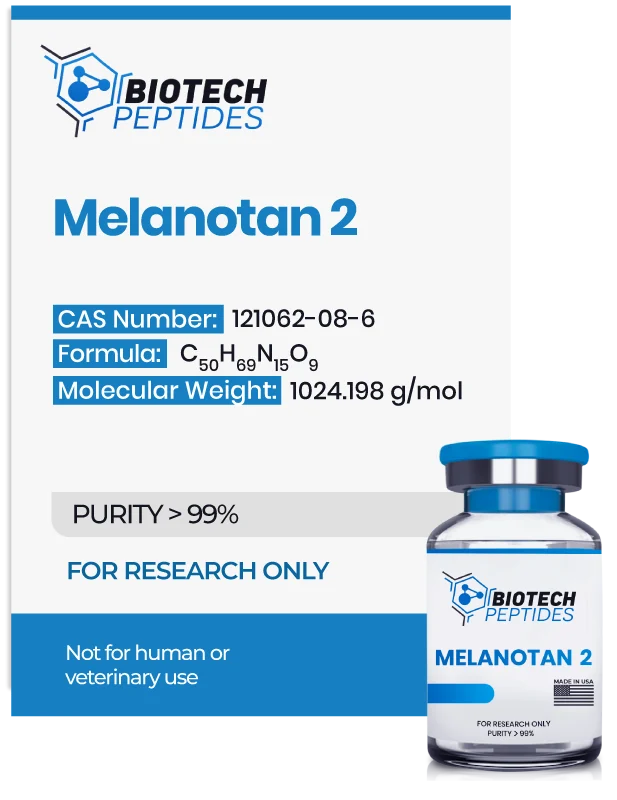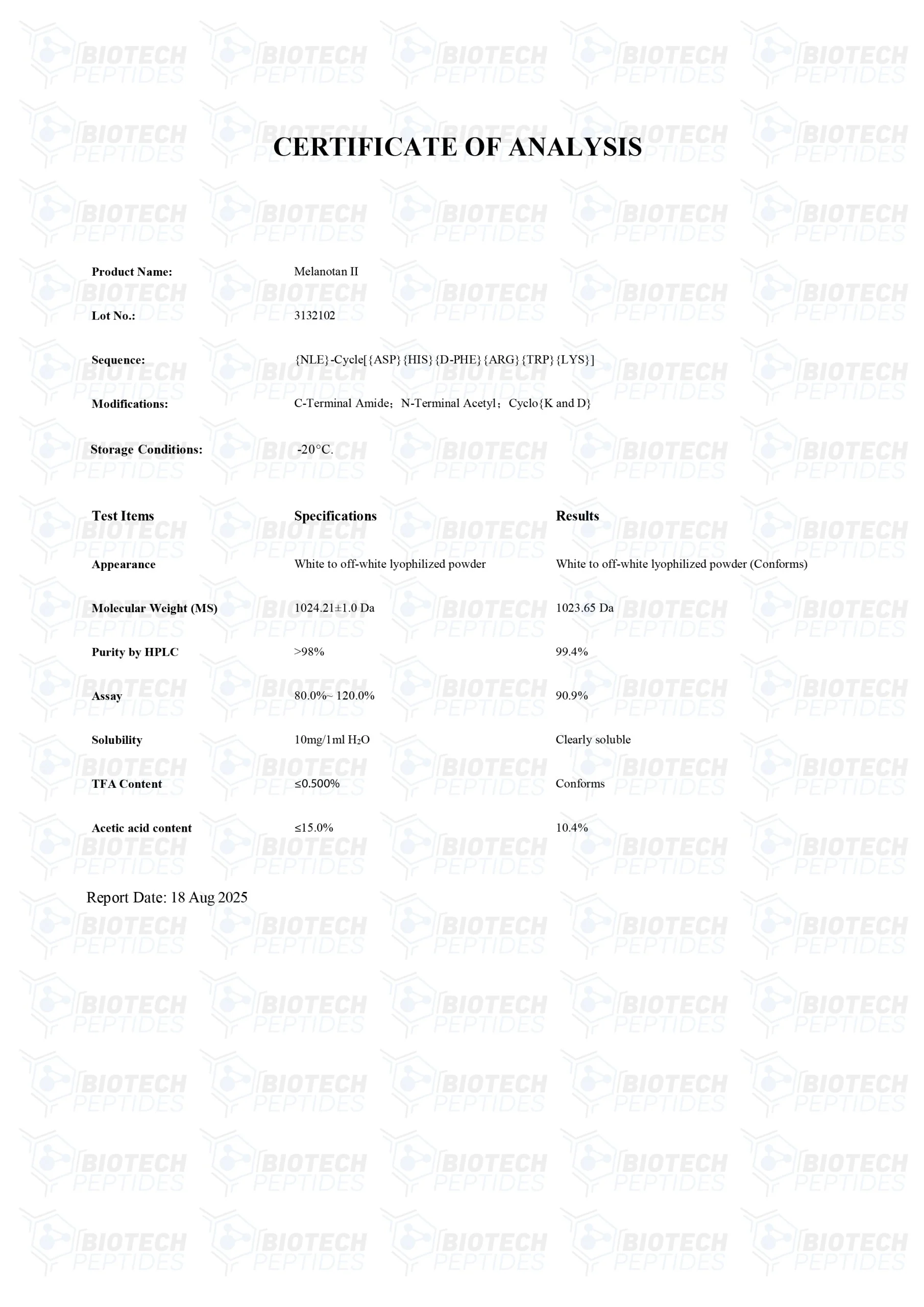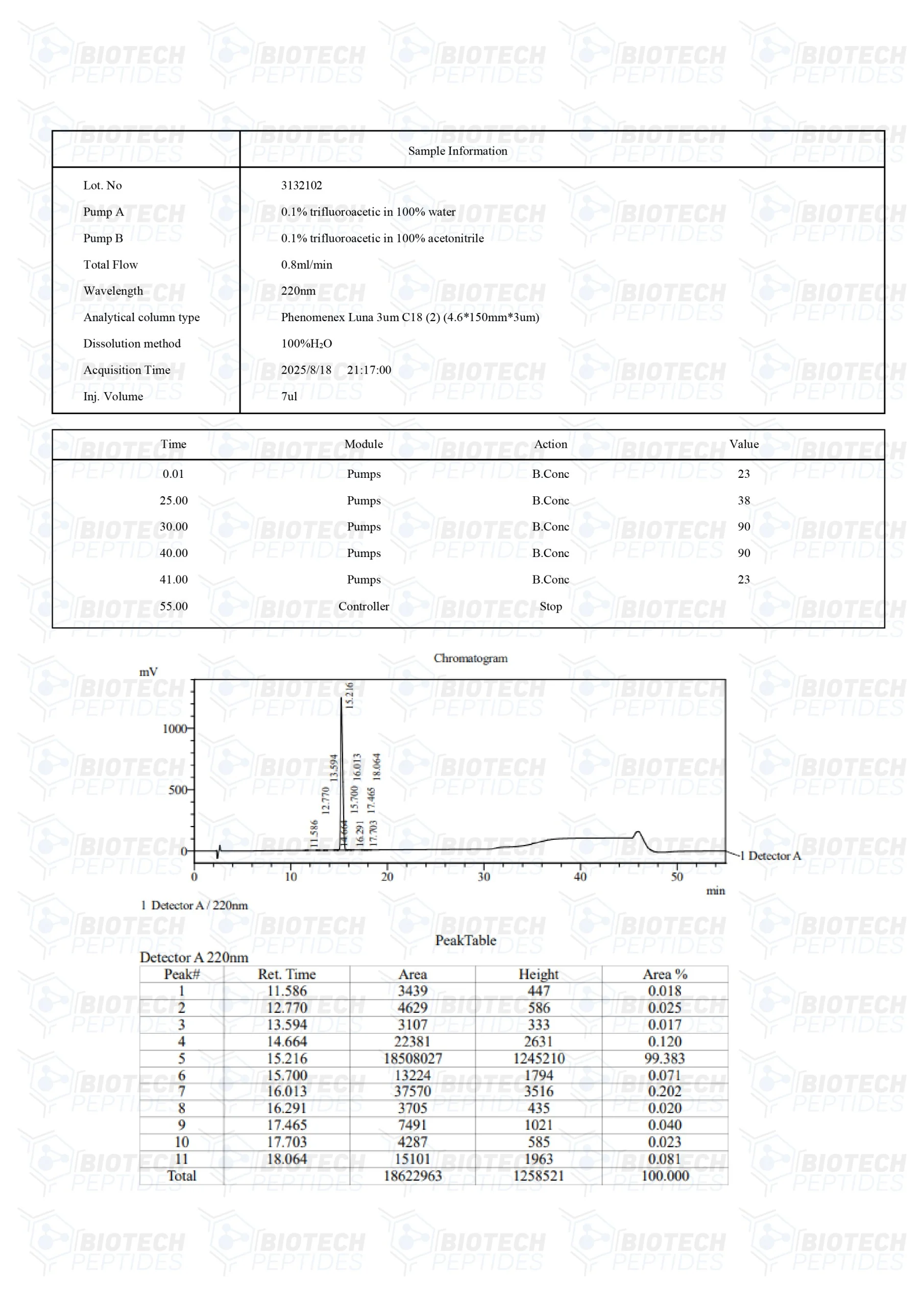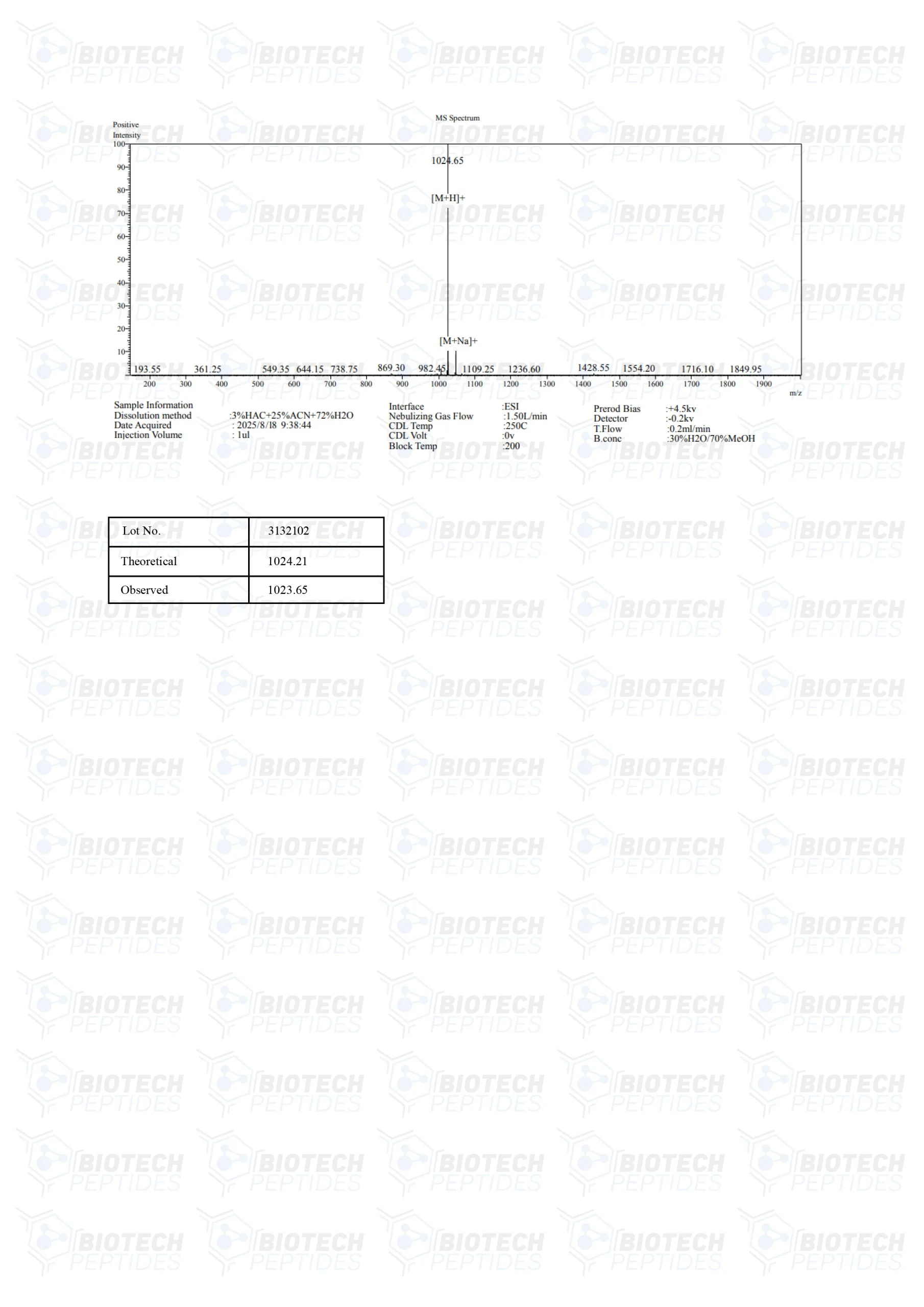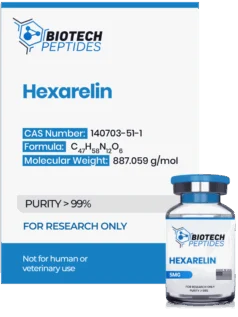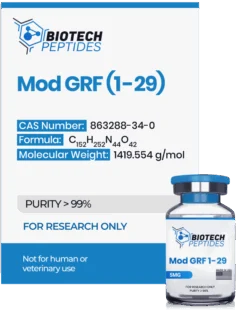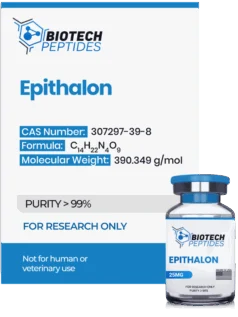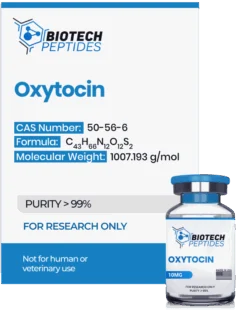Melanotan 2 (2mg & 10mg)
Price range: $16.00 through $47.00
Melanotan 2 peptides are Synthesized and Lyophilized in the USA.
Discount per Quantity
| Quantity | 5 - 9 | 10 + |
|---|---|---|
| Discount | 5% | 10% |
| Price | Price range: $15.20 through $44.65 | Price range: $14.40 through $42.30 |
FREE - USPS priority shipping
Melanotan 2 Peptide
Melanotan 2 (MT-2) is a synthetic analog of the alpha-melanocyte-stimulating hormone (alpha-MSH). A study conducted at the University of Arizona observed the involvement of alpha-MSH in skin pigmentation in rodents.[1] This finding then led to the development of MT-2 in the 1980s by a team of researchers at the university. It has been examined frequently in laboratory settings to determine its potential in melanin production and various ancillary impacts on the brain.
Specifications
Other Known Titles: MT-2
Molecular Formula: C50H69N15O9
Molecular Weight: 1024.19 g/mol
Sequence: Ac-Nle-Asp(1)-His-D-Phe-Arg-Trp-Lys(1)-NH2
Melanotan 2 Research
Melantotan 2 (MT-2) and Melanocortin Signaling
Melanotan 2 appears to associate with Melanocortin receptors to mediate its biological function. There are five known Melanocortin receptors, each considered to be involved in a different function. Studies posit that MT-2 appears to have a strong binding affinity to MC-4R and MC-1R, which are considered to induce changes in hunger hormone signaling and energy homeostasis, and stimulation of melanocytes respectively, and may bind weakly to MC-3R, which appears to engage with appetite control.[2]
Melantotan 2 (MT-2) and Autism
MT-2, which has been researched in relation to oxytocin release, was studied in a murine model of autism spectrum disorder (ASD).[3] The work aimed to explore the impact in autism symptoms under the influence of MT-2. The peptide exposure appeared to help increase communication, affected social interaction, and repetitive behavior observed in the affected mice. At a molecular level, MT-2 exposure appeared to enhance the expression of oxytocin receptors in the affected areas of the mice brain, establishing a direct correlation between ASD-mediated behavior and oxytocin signaling.
Melantotan 2 (MT-2), Impulse Control
The MC-4R receptor has been considered to influence impulse control. Previous findings suggest that MT-2 exposure may promote water uptake and reduce the consumption of alcohol in rats that prefer alcohol consumption.[4] Naltrexone and Melanotan 2 combination appears to supress binge uptake of ethanol in rats synergistically up to seven-fold. The various observations suggest that the peptide regulates the basic process of desire and craving in the mammalian brain apart from being effective in alcohol-associated disorders. It helps illustrate a better understanding of oxytocin regulation in impulsive behavior.
Melantotan 2 (MT-2) and Hunger Hormone Signaling
MT-2 studies suggest the peptide's potential in hormone signaling, hunger behavior, and fat cell storage in animal models through interaction with the melanocortin-4 receptor (MC-4R).[5] The researchers commented that “brain MC4R is intimately involved in the control of food intake and body weight and provide evidence that selective activation of MC4R causes anorexia that is not secondary to aversive effects.” MT-2 appears to act as an agonist for MC-4R. Mice exposed to MT-2 were reported to not only take up significantly less food but also ignore fatty foods in terms of their preference. Similarly, mice mutants of the MC-4R receptor consume fatty foods almost exclusively and appear to be resistant to the effects of the Melanotan 2 peptide. The alleged effects of MT-2 can be compared to those of the hormone leptin, sometimes known as “the satiety hormone,” because it controls cravings and food intake. Leptin, however, has not been observed in research studies to make any perceptible impact in obesity cases, even in leptin-deficient research models. This is likely due to the presence of two pathways for satiety, called leptin-dependent and leptin-independent pathways. Research suggests MT-2 may stimulate the pathways and therefore may be potentially more effective in controlling hunger. Experimental observations further suggest that MC-4R stimulation by MT-2 also may induce gene expression of the leptin target thyrotropin-releasing hormone (TRH). Both MT-2 and leptin may induce expression of TRH in the paraventricular nucleus of the hypothalamus, a region of the brain which regulates feelings of satiety and food intake. However, only elevated levels of MT-2 appear to cross into the central nervous system to influence TRH expression.
Melantotan 2 (MT-2) and Diabetes
Elevated blood sugar levels, hypersecretion of glucagon hormones, and production of ketone bodies mark the pathogenesis of diabetes. Leptin is considered to counteract these pathogenic alterations. The mode of action of leptin is independent of insulin and hence is explored as an alternative in diabetes research.[6] Scientific research posits that leptin and MT-2 may mediate similar effects through Melanocortin receptors. This is significant as leptin’s mode of action is considered to be restricted to the brain, and it does not appear to be able to cross the blood-brain barrier as readily as MT-2 has been suggested to be. Thus, exogenous leptin may not be able to reach CNS.
Melantotan 2 (MT-2) and Erectile Dysfunction
Vascular issues often contribute to erectile dysfunction (ED). ED symptoms have been posited to improve with increased blood flow to the erectile muscles, and a reduction in vascular resistance. However, select forms of ED do not appear to stem from vascular resistance. Therefore, compounds that increase blood flow may be ineffective against such forms of ED as well as against hypoactive sexual desire disorder in female animal models. MT-2 may be an alternative research entity due to its suggested influence on CNS.[7]
Disclaimer: The products mentioned are not intended for human or animal consumption. Research chemicals are intended solely for laboratory experimentation and/or in-vitro testing. Bodily introduction of any sort is strictly prohibited by law. All purchases are limited to licensed researchers and/or qualified professionals. All information shared in this article is for educational purposes only.
References
- Dorr RT, Lines R, Levine N, Brooks C, Xiang L, Hruby VJ, Hadley ME. Evaluation of melanotan-II, a superpotent cyclic melanotropic peptide in a pilot phase-I clinical study. Life Sci. 1996;58(20):1777-84. doi: 10.1016/0024-3205(96)00160-9. PMID: 8637402.
- Yeo GSH, Chao DHM, Siegert AM, Koerperich ZM, Ericson MD, Simonds SE, Larson CM, Luquet S, Clarke I, Sharma S, Clément K, Cowley MA, Haskell-Luevano C, Van Der Ploeg L, Adan RAH. The melanocortin pathway and energy homeostasis: From discovery to obesity therapy. Mol Metab. 2021 Jun;48:101206. doi: 10.1016/j.molmet.2021.101206. Epub 2021 Mar 6. PMID: 33684608; PMCID: PMC8050006.
- Minakova E, Lang J, Medel-Matus JS, Gould GG, Reynolds A, Shin D, Mazarati A, Sankar R. Melanotan-II reverses autistic features in a maternal immune activation mouse model of autism. PLoS One. 2019 Jan 10;14(1):e0210389. doi: 10.1371/journal.pone.0210389. PMID: 30629642; PMCID: PMC6328175.
- Navarro M, Carvajal F, Lerma-Cabrera JM, Cubero I, Picker MJ, Thiele TE. Evidence that Melanocortin Receptor Agonist Melanotan-II Synergistically Augments the Ability of Naltrexone to Blunt Binge-Like Ethanol Intake in Male C57BL/6J Mice. Alcohol Clin Exp Res. 2015 Aug;39(8):1425-33. doi: 10.1111/acer.12774. Epub 2015 Jun 24. PMID: 26108334; PMCID: PMC4515169.
- Benoit SC, Schwartz MW, Lachey JL, Hagan MM, Rushing PA, Blake KA, Yagaloff KA, Kurylko G, Franco L, Danhoo W, Seeley RJ. A novel selective melanocortin-4 receptor agonist reduces food intake in rats and mice without producing aversive consequences. J Neurosci. 2000 May 1;20(9):3442-8. doi: 10.1523/JNEUROSCI.20-09-03442.2000. PMID: 10777807; PMCID: PMC6773132.
- Heijboer AC, van den Hoek AM, Pijl H, Voshol PJ, Havekes LM, Romijn JA, Corssmit EP. Intracerebroventricular administration of melanotan II increases insulin sensitivity of glucose disposal in mice. Diabetologia. 2005 Aug;48(8):1621-6. doi: 10.1007/s00125-005-1838-8. Epub 2005 Jun 22. PMID: 15971058.
- Wessells H, Fuciarelli K, Hansen J, Hadley ME, Hruby VJ, Dorr R, Levine N. Synthetic melanotropic peptide initiates erections in men with psychogenic erectile dysfunction: double-blind, placebo controlled crossover study. J Urol. 1998 Aug;160(2):389-93. PMID: 9679884.
- Giuliano F, Clément P, Droupy S, Alexandre L, Bernabé J. Melanotan-II: Investigation of the inducer and facilitator effects on penile erection in anaesthetized rat. Neuroscience. 2006;138(1):293-301. doi: 10.1016/j.neuroscience.2005.11.008. Epub 2005 Dec 19. PMID: 16360286.

